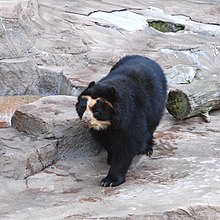Tremarctinae
| Tremarctinae Temporal range:
| |
|---|---|

| |
| A spectacled bear in Tennōji Zoo, Osaka. | |
| Scientific classification | |
| Domain: | Eukaryota |
| Kingdom: | Animalia |
| Phylum: | Chordata |
| Class: | Mammalia |
| Order: | Carnivora |
| Family: | Ursidae |
| Subfamily: | Tremarctinae Merriam & Stock, 1925 |
| Genera | |
The Tremarctinae or short-faced bears is a subfamily of Ursidae that contains one living representative, the spectacled bear (Tremarctos ornatus) of South America, and several extinct species from four genera: the Florida spectacled bear (Tremarctos floridanus), the North American short-faced bears of genera Plionarctos (P. edensis and P. harroldorum) and Arctodus (A. pristinus and A. simus), and the South American giant short-faced bears of Arctotherium (including A. angustidens, A. vetustum, A. bonariense, A. wingei, and A. tarijense).[1] The group is thought to have originated in eastern North America, and then invaded South America as part of the Great American Interchange.[2]
Systematics
Traditionally the phylogenetic inner relationships of tremarctines had Plionarctos and Tremarctos being basal groups with respect to a short-faced bear clade of Arctodus and Arctotherium.[3][4] A study of the affinities of bears belonging to Arctotherium indicates that they were more closely related to the spectacled bear than to Arctodus, implying convergent evolution of large size in the two lineages.[5]
Taxonomy
The following taxonomy of the tremarctine bears follow by Mitchell et al. (2016)[5]:
- Subfamily Tremarctinae (Merriam & Stock, 1925)
- †Plionarctos (Frick, 1926)
- †Plionarctos harroldorum (Tedfored & Martin, 2001)
- †Plionarctos edensis (Frick, 1926)
- †Arctodus (Leidy, 1854)
- †Arctodus simus (Cope, 1879)
- †Arctodus pristinus (Leidy, 1854)
- †Arctotherium (Burmeister, 1879)
- †Arctotherium angustidens (Gervais & Ameghino, 1880)
- †Arctotherium vetustum (Ameghino, 1885)
- †Arctotherium wingei (Ameghino, 1902)
- †Arctotherium bonariense (Gervais, 1852)
- †Arctotherium tarijense (Ameghino, 1902)
- Tremarctos (Gervais, 1855)
- †Tremarctos floridanus (Gildey, 1928)
- Tremarctos ornatus (Cuvier, 1825) – spectacled bear
- †Plionarctos (Frick, 1926)
See also
References
- ^ Krause, J.; Unger, T.; Noçon, A.; Malaspinas, A.; Kolokotronis, S.; Stiller, M.; Soibelzon, L.; Spriggs, H.; Dear, P. H.; Briggs, A. W.; Bray, S. C. E.; O'Brien, S. J.; Rabeder, G.; Matheus, P.; Cooper, A.; Slatkin, M.; Pääbo, S.; Hofreiter, M. (2008-07-28). "Mitochondrial genomes reveal an explosive radiation of extinct and extant bears near the Miocene-Pliocene boundary". BMC Evolutionary Biology. 8: 220. doi:10.1186/1471-2148-8-220. PMC 2518930. PMID 18662376.
{{cite journal}}: CS1 maint: unflagged free DOI (link) - ^ Soibelzon, L.H.; Tonni, E.P.; Bond, M. (2005). "The fossil record of South American short-faced bears (Ursidae, Tremarctinae)". Journal of South American Earth Sciences. 20 (1–2): 105–113. doi:10.1016/j.jsames.2005.07.005. Retrieved 2019-02-21.
- ^ Soibelzon, Leopoldo H.; Rincón, Ascanio D. (2007). "The fossil record of the short-faced bears (Ursidae, Tremarctinae) from Venezuela. Systematic, biogeographic, and paleoecological implications". Neues Jahrbuch für Geologie und Paläontologie, Abhandlungen. 244 (3): 287–298. doi:10.1127/0077-7749/2007/0244-0287.
- ^ Soibelzon, Leopoldo H.; Schubert, Blaine W. (2011). "The largest known bear, Arctotherium angustidens, from the early Pleistocene pampean region of Argentina: with a discussion of size and diet trends in bears". Journal of Paleontology. 85 (1): 69–75. doi:10.1666/10-037.1.
- ^ a b "Ancient mitochondrial DNA reveals convergent evolution of giant short-faced bears (Tremarctinae) in North and South America". Biology Letters. 12 (4): 20160062. 2016. doi:10.1098/rsbl.2016.0062. PMC 4881349. PMID 27095265.
{{cite journal}}: Unknown parameter|authors=ignored (help)
